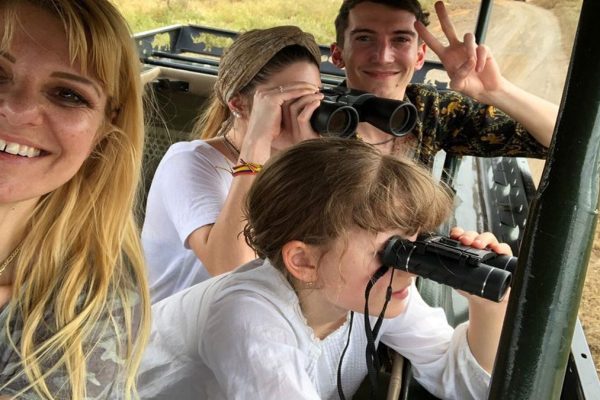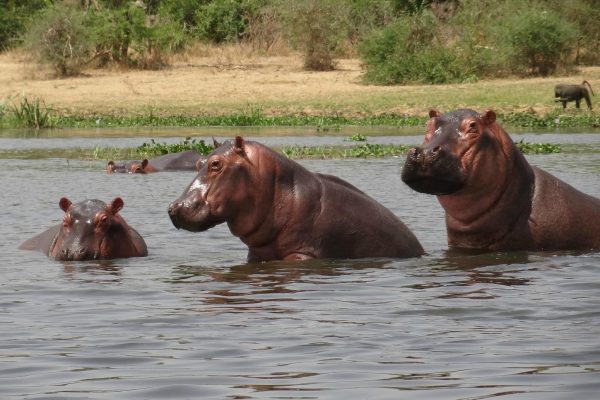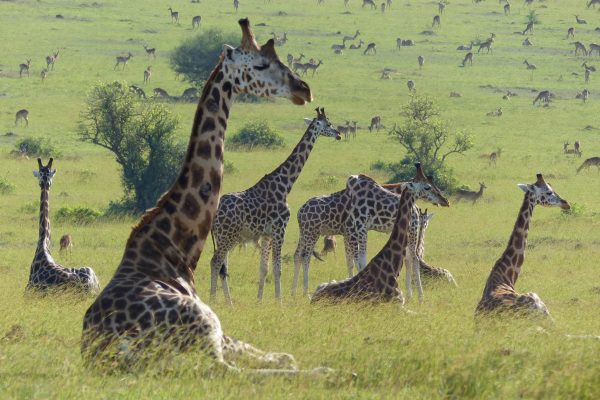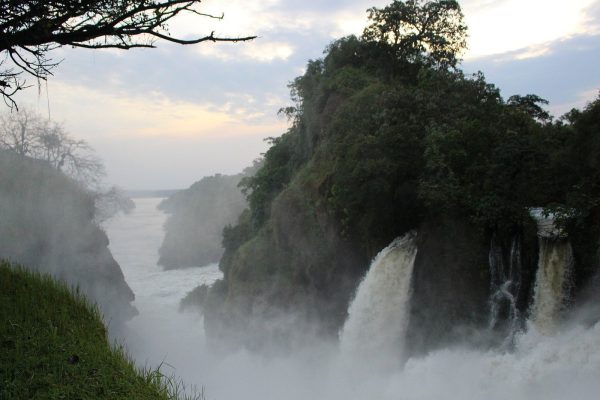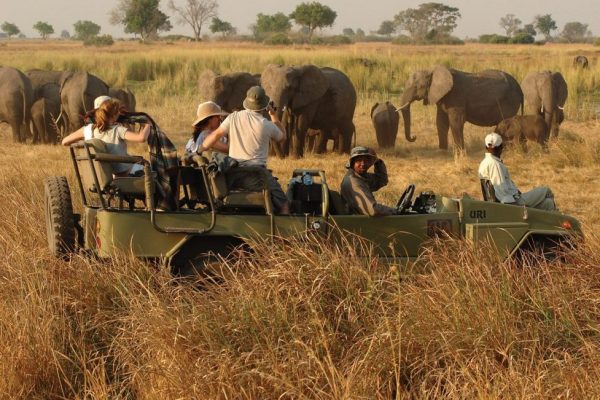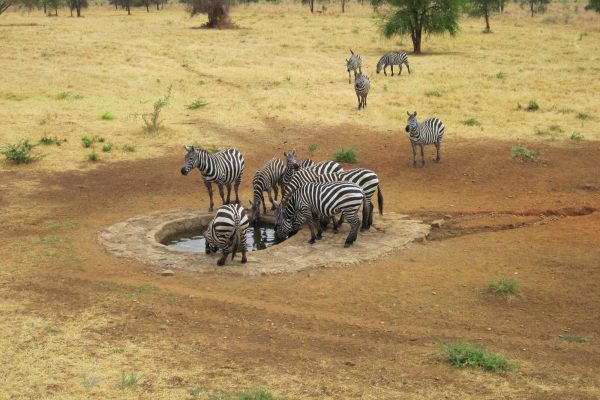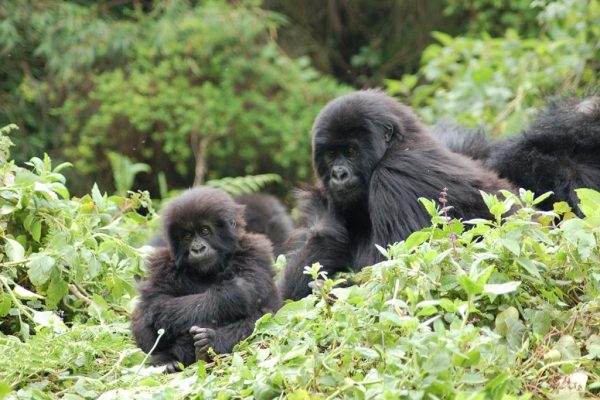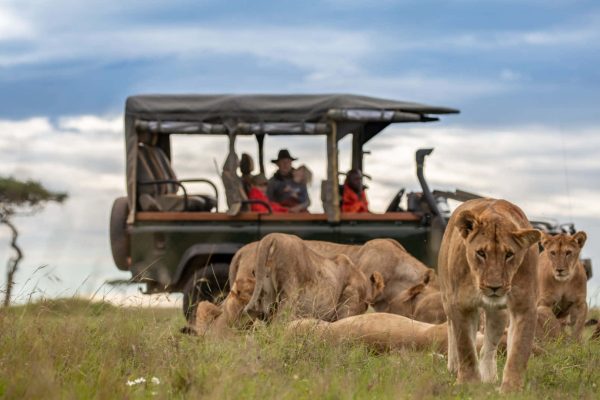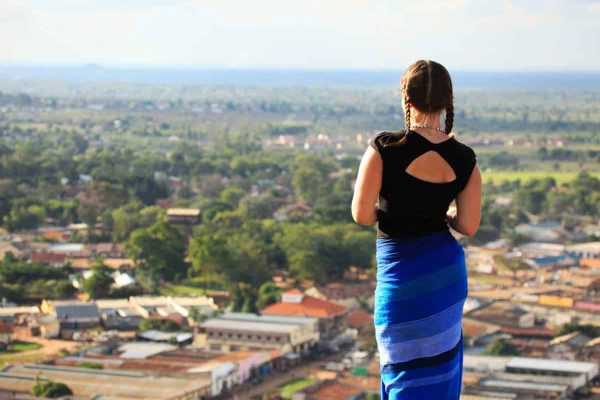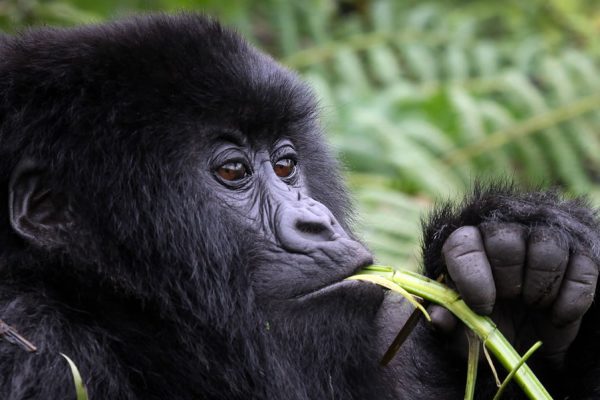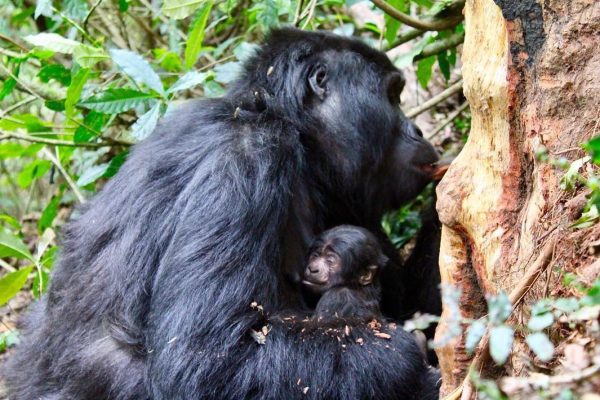Guided Murchison Falls Safaris And Tours
Learn about the amazing wildlife that can be seen on safari in Murchison Falls National Park. Murchison Falls, the park’s stunning cascade, is also discussed. You can see it by taking a Nile cruise and then hiking to the summit for an incredible view!
The largest and most exciting game park in Uganda is Murchison Falls National Park. It is within the East African Rift and shares a boundary with Lake Albert in the country’s west. The Victoria Nile flows through the park, producing a delta, before emptying into Lake Albert. Along the way, the river crashes through Murchison Falls, creating the world’s largest natural water force.
Murchison Falls National Park is home to a diverse range of gorgeous scenery as well as a plethora of species. Lions, elephants, giraffes, and leopards are among the huge creatures that can be seen. The park is also home to well-known birds such as the grey crested crane and the shoebill. Visitors to the park can experience game drives, boat safaris, and a waterfall walk, which are all very tourist-friendly.
Here’s our top ten list of reasons to Safari Murchison Falls National Park!
Murchison Falls National Park | Uganda
Murchison Falls is awe-inspiring: Murchison Falls Safaris
The Victoria Nile, which is generally wide and fast-flowing, is forced to tighten up and squeeze through a short, seven-meter breach on the edge of an escarpment in the midst of Murchison Falls National Park. This causes the water to rush over the edge, resulting in a raging white-water waterfall. Despite the fact that the drop is only 43 meters (141 feet), the intensity and power of the falls, as well as the lush forest surroundings, combine for a breathtaking spectacle.
Murchison Falls is actually made up of two waterfalls: the main drop and Uhuru Falls, a smaller, more vertical cascade immediately to the north. Anyone who has climbed Mount Kilimanjaro will be familiar with the name uhuru, which means “freedom” in Swahili.
Murchison Falls Safari Packages
1 Day Murchison Falls Safari
This one-day Murchison Falls safari trip to Murchison Falls National Park from Kampala features a visit to the top of the falls, a boat cruise on the Nile River banks, and a game drive in search of wildlife. About 76 mammal species including Elephants, Buffaloes, Lions, and Leopards are found in the park. Almost 450 bird species, Aquatic species, butterflies, reptiles, and many more species can be seen in the park.
Murchison Falls Safari And Ziwa Rhinos
Activities in 3 Days Murchison Falls Safari include a game drive, boat cruise, and hike to the top of the falls. Rhino tracking will be at Ziwa Rhino Sanctuary before reaching Murchison Falls Park and the chimpanzee trekking in the adjacent Budongo Forest on the last day on return from the Murchison Falls safari. Murchison Falls National Park safaris are the most popular short safaris in Uganda on wildlife tours and boat cruises to the world’s most powerful waterfalls-Murchison Fall.
2 Days Safari to Murchison Falls
For this 2 Days Safari to Murchison Falls National Park, the tour is private, affordable, and can be undertaken at any time of the year. Included in the package is a professional Uganda safari driver guide, accommodation, entrance fees and accommodation, meals, and transportation with a 4×4 safari vehicle. Murchison Falls safaris are the most popular short tours in Uganda on wildlife tours and boat cruises to the worlds’ most powerful waterfalls-Murchison Falls. Murchison Falls National Park
Murchison Falls Safari and Chimp Trekking
The Remarkable 4 Days Murchison Falls Safari to Murchison Falls National Park. 4 Days Murchison Falls Safari also offers Chimpanzee trekking in Budongo forest. Murchison Falls National Park is the largest and oldest Uganda safari park within the Murchison Falls Conservation Area which is where the Budongo forest is found.
Murchison Falls Kidepo Pian Upe Safari
9 Days in Murchison Falls Kidepo Pian Upe Safari Itinerary – Murchison Falls National Park, Pian Upe Game Reserve, Sipi Falls, and Kidepo Valley National Park are all within easy driving distance of each other in the Karamoja region of northeastern Uganda, which is situated between the borders of Kenya and Sudan. Exciting activities await you on this safari, such as a cultural tour where you can meet the local Karamojong people, game drives.
Murchison Falls And Kidepo Full Itinerary
Ultimate Guide to Murchison Falls And Kidepo Full Itinerary. The north of Uganda is a haven for travelers with a penchant for breathtaking scenery, a wide variety of animals, and a hint of the uncharted wilderness of central Africa beyond the boundaries. You can have all the comforts of home while still engaging in true exploring at one of these luxurious lodges.
The view is diverse and lovely.
Murchison Falls National Park is divided in two by the Victoria Nile, which creates a northern and southern part. Tall grasslands (interspersed with Borassus palms), acacia trees, and riverine woods characterize the northern portion. Wooded savannah and extensive tropical forest characterize the southern portion. There is a large wetland in the west, where the Victoria Nile empties into Lake Albert.
The vistas throughout the park are both magnificent and surprising at times. It’s a fantastic site for landscape photographers to put their skills to the test. Murchison Falls, with its twin waterfalls, is, of course, the park’s most famous sight. The riverbanks and the Victoria Nile delta, which are both teeming with waterbirds, waders, and other animals, are also worth noting.
Murchison Falls National Park is home to 775 plant species. Acacia, sycamore fig, Borassus palm, mahogany, sausage, and dombeya are among the 145 tree species (wild pear). Strangler figs can also be seen in the park’s forested areas; these are tree species that climb up and around larger, more established trees, often killing the support tree.
The game spotting is fantastic.
Murchison Falls National Park is home to at least 109 animal species, according to a 2015 census. Many of them are huge mammals, such as lions, leopards, antelopes, and elephants, which are popular safari animals. The presence of the Victoria Nile in the park contributes to the abundance of wildlife since willowers and other thirsty animals congregate in the river and its wetlands. You can expect to encounter hippos, elephants, crocs, and other spectacular species when you go to the water.
The creatures in the Murchison Falls National Park that inspire people to ooh and flap their hands in their friends’ faces to get them to look over there are listed below:
Bush elephants, Lions, Leopards, Cape buffaloes, Rothschild’s giraffes, Spotted hyenas, Patas monkeys, Vervet monkeys, Anubis baboons, Jackson’s hartebeests, Uganda kobs, Defassa waterbucks, Grey duikers, Bushbuks Bohor, reedbucks
Hundreds of Patas monkeys can be spotted.
The patas monkey is an Old World monkey that lives in West, Central, and Eastern Africa’s savannahs. Wadi monkey and hussar monkey are two names given to it. It stands out thanks to the orange fur on its head, back, and flanks. The majority of its belly and legs are yellowish. Male patas monkeys are significantly larger than females; adult males weigh roughly 12 kg (27 lb), while adult females weigh around 6.5 kg (14 lb).
Patas monkeys, unlike most monkeys, spend most of their time on the ground. Murchison Falls National Park is one of the greatest sites to see them, as they dwell in large numbers here and appreciate the park’s broad savannah. And because they’re gregarious animals who live in large groups, you’re likely to see a lot of them if you see one. In reality, their forces can number up to 60 people!
Patas monkeys are the world’s fastest primates. This is what they use to help them survive. If a predator, such as a cheetah, is detected, the alpha male makes himself visible and then rushes off at a high rate, luring the predator away from the rest of the troop. Indeed, chivalry!
There are tree-climbing lions: Murchison Falls Safaris
Most lions do not climb trees, despite the fact that you may not have realized it. Of course, it’s not that they can’t; it’s just that they don’t. They prefer to sleep, socialize, and clean themselves on the grass and on rocks instead. However, lion populations in Uganda and northern Tanzania are recognized for their tree-climbing behaviors. A lion, similar to a leopard, reclining on a tree or standing and scanning the surrounding area from this useful vantage point is an extremely exciting sight.
Murchison Falls National Park is one of the few sites in the world where lions can climb and rest in trees. They prefer spread trees like sycamore figs and acacias, which have long, simple branches that are nice to lie on.
Murchison Falls National Park has lions all over it. The Queen’s and Victoria Nile Tracks, on the other hand, provide the finest opportunities for sightings.
Amazing Wildlife Safari in Murchison Falls National Park
Rare Rothschild’s giraffes live in the park
Murchison Falls National Park is also known for its population of rare and endangered Rothschild’s giraffes. The Rothschild’s giraffe, a subspecies of the northern giraffe, is a critically endangered species that can only be found in Uganda and a small area of southern Kenya.
The ossicones, or skin-covered bone protuberances on the head of Rothschild’s giraffe, are one of its defining traits. It possesses the most ossicones of any giraffe, at five. The tallest ossicones are the two parietal ossicones on top of the head, which are present in all giraffe species. Rothschild’s giraffes, on the other hand, have two smaller ones, one behind each ear and one in the center of the forehead.
Looking at the lower legs of Rothschild’s giraffe is by far the best way to tell it apart from other giraffe species and subspecies. The patches that cover the rest of its body fall away around the knee, leaving no marks. The giraffe’s lower legs are a solid creamy color that almost looks like he’s wearing knee-high socks.
Giraffes have the longest gestation time of any mammal, aside from elephants, whales, and rhinos. Giraffes normally only have one foetus at a time, which is carried for 14 to 16 months in the uterus. Murchison Falls National Park is one of the greatest places to watch Rothschild’s giraffes, with more than half of them living there!
Ugandan kobs live here in great numbers
Uganda safaris are known for the Ugandan kob. One explanation for this is its narrow range: it can only be found in Uganda, South Sudan, and the Democratic Republic of the Congo. It’s also Uganda’s most famous antelope, appearing on the country’s coat of arms.
Ugandan kobs are frequently misidentified as impalas. And certainly, the two species have a striking resemblance. Impalas and kobs, however, do not belong to the same genus. The Ugandan kob belongs to the genus kobus, whereas the impala belongs to the genus aepyceros.
The Ugandan kob can be found in both open and woodland savannah as well as grassland. Murchison Falls National Park is home to a big population of Ugandan kobs, so a Murchison Falls Safari there should allow you to view several of these graceful creatures. You’ll be able to differentiate the men from the females if you see them because only the males have horns.
There are 450 bird species, including the shoebill
Shoebill storks (also called as whalehead storks, whale-headed storks, and shoe-billed storks) are huge, unique, and unappealing birds. To say the least, that iconically huge beak appears gigantic. They are, nonetheless, intriguing birds (perhaps partly for that reason).
Shoebills prefer to spend their time in marshes, where they catch their prey. They’re superb hunters, pursuing species that are only a fraction of their size, such as monitor eels, lizards, and even newborn crocodiles! Read The Shoebill: Or, the Most Terrifying Bird in the World for a vivid and more thorough explanation of the shoebill. The greatest spot to see shoebills in Murchison Falls National Park is along the Victoria Nile between Nile Safari Lodge and the river delta at Lake Albert.
Around 500 bird species can be found at Murchison Falls National Park. The following are some of the flying critters that frequent the park and make bird-spotters (oops) go crazy:
Abyssinian ground hornbills, Blue-headed coucals, Red-winged grey warblers, White-crested turacos, Red-headed lovebirds, Shoebills, Black-billed barbets, Red-throated bee-eaters, Grey-headed, woodland and giant kingfishers, Grey-crowned cranes, Speckle-fronted, weavers, Black-headed lapwings, Palm-nut vultures, Senegal thick-knees, Squacco and goliath herons, Denham’s bustards, Black-headed and papyrus gonoleks, Silverbirds
You can go on a boat safari
Boat safaris are a unique experience that only a few parks can provide. A boat safari on the Victoria Nile is available at Murchison Falls National Park. This allows you to observe and appreciate the park’s various creatures and features.
The safari boat excursion begins 15 kilometers downstream from Murchison Falls in Paraa, which in Luo means “place of hippos.” The most popular choice is to take a boat through Fajao Gorge, which takes you upriver. The densely forested walls climb up to encircle the river and block out the rest of the world. You have the impression that you are entering a remote and mysterious universe of primal rhythms and cycles. Finally, you hear pounding water and are rewarded with a breathtaking vista of Murchison Falls.
You can also take a 15-kilometer boat ride downriver to the delta, where the Nile flows into Lake Albert. This area is rich in birdlife and wildlife, as well as being quite green and beautiful. A safari drive back to the park’s headquarters in Paraa can be arranged.
In the park, there are both group and private boat safari experiences available. If you like, you can even go on a fishing boat cruise. The boats feature roofs, which are useful for keeping you protected from the sun. There are a variety of cruise departure times available, including morning and afternoon departures. Those who are interested can take a sundowners boat and observe the safari while sipping a glass of wine!
You can hike to the top of the waterfall
You can climb from the river up to the Top of the Falls Viewpoint on the river’s south bank if conditions are favorable! This is a difficult trek, but it is rewarded with an incredible vista, a loud music, and a refreshing shower.
To get to the start of the trail leading to the Top of the Falls Viewpoint, you’ll need to take a boat ride. After that, you climb for about an hour to reach the viewpoint. The majority of people then take a 4×4 journey back to Paraa. Do you dislike hiking? No worries, the drive back to Paraa can take you to the Top of the Falls Viewpoint as well.
Aside from the Top of the Falls Viewpoint, there are additional wonderful perspectives to see, but they require time to reach, so you’ll need to add another hour to your overall time.
Want to visit Murchison Falls National Park?
Our Ugandan guide, Dan, enjoys taking guests to the Murchison Falls National Park. He couldn’t determine which month was his favorite when we asked him. He claims that April is the only month that isn’t great due of the seasonal rain. But, as he points out, rain isn’t all terrible because animals don’t enjoy damp grass, which pushes them to seek out dry roadways, making them easy to find! Please read When is the best time to visit Uganda? for additional information on the best time to visit Murchison Falls National Park.
Most visitors to Uganda who come to see Murchison Falls also enjoy going gorilla trekking in Bwindi Forest and climbing in the breathtaking Rwenzori mountain range. Please see our fascinating Uganda itineraries to see the sites and activities that we believe make up the ideal Uganda vacation!
Ready for an adventure?
Guide to Gorilla Trekking in Bwindi
Gorilla trekking is hard work, but the rewards are immense. Adult Gorilla photographed by the habituation team. Complete Guide to planning your Gorilla trekking safari to Bwindi – our full guide on planning your gorilla trekking safari to Uganda’s Bwindi will equip you with the best knowledge required for a successful gorilla trekking safari.
Gorillas and Masai Mara Safari
Enjoy gorilla trekking in Uganda and a big 5 wildlife safari in Maasai Mara with Exclusive Mountain Gorillas and Masai Mara Safari. Includes gorilla hike permits in Uganda, all lodging with meals in Bwindi and Mara, wildlife safari park fees, flights between Uganda and Kenya, and transfers. Starting with Bwindi Impenetrable National Park, where we spent three days on a gorilla hike, we flew to Kenya.
Discover/Explore Uganda
Uganda is a lovely and entertaining place! Uganda is a very nice country with a very conducive climate, favorable weather for all visitors and residents alike, good and green vegetation that attracts people, and wild animals in national parks such as lions, elephants, buffalos, zebras, giraffes, waterbucks, rhinos, leopards, and many others, beautiful landscapes to name a few. This leads to Uganda being dubbed the “Pearl of Africa”.
Things to Do in Uganda, Attractions
Top Uganda Safari Activities – Beyond climbing to view mountain gorillas, Uganda has a lot to offer. Amazing animals, adrenaline-pumping activities, hikes and waterfalls, cultural encounters, and more are all on the menu! Here are our top 20 recommendations for things to do in Uganda. Uganda is one of the world’s most thrilling and gorgeous vacation spots. Uganda is the ideal location for anyone interested in landscapes, wildlife, culture, or simply seeking adventure.
8 Days in Uganda Itinerary
This Safari in Uganda is specifically for budget travelers who would love to have a low-budget safari and sleep in budget accommodation facilities. On this 8 Day in Uganda, you will do these activities; visiting the equator line, Gorilla trekking, Game drive, boat cruise, and a nature walk. The long Uganda Safari starts and ends at Entebbe International Airport with 8 days and 7 nights on tour.
Fly-in Safari to Bwindi & Murchison Falls
The 6 Days Uganda Fly-in Safari tour comprises activities like mountain gorilla trekking at Bwindi Impenetrable National Park and a game drive, boat cruise, and hike to the top of the falls at Murchison Falls National Park. Mountain Gorilla trekking is one of the popular Uganda safari activities and the Bwindi forest offers such a remarkable experience. It’s such a wonderful moment spending several hours walking/hiking through a tropical jungle in search of mountain gorillas and spending 1 hour in their presence.

